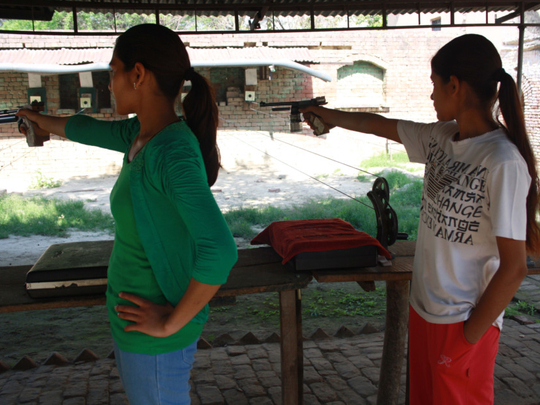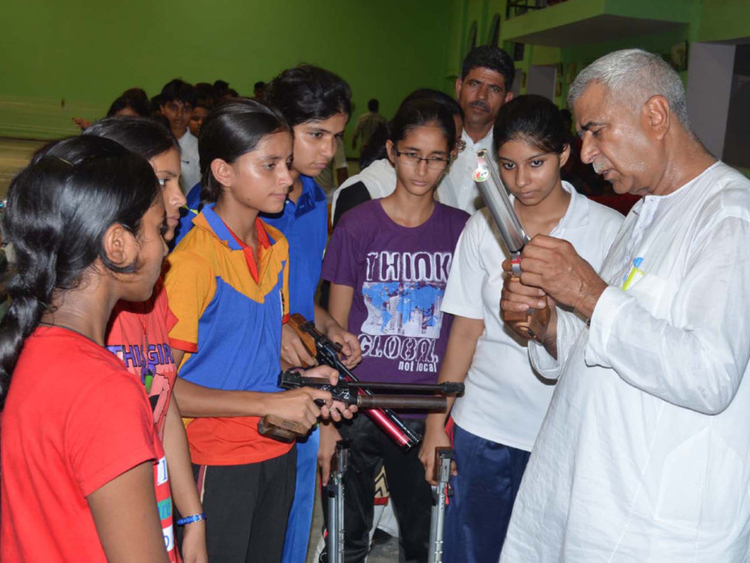
Dressed in a T-shirt and trousers, Khushi Tomar holds the 10-metre air pistol in her right hand and slowly raises it. Focusing on her target about 10 metres away, she squeezes her index finger curled around the trigger. The silence is shattered by a gunshot that finds its mark on a dummy at the B.P. Singhal Indoor Shooting Range in Baghpat district in the northern Indian state of Uttar Pradesh.
Khushi misses the bull’s eye merely by an inch and the budding shooter gets ready for the next shot. At just 10 years of age, Khushi is sure to make India proud in the coming years. Training at the shooting range, she is hoping to follow in the footsteps of not just her sister Priya, a state-level shooter, but generations of women shooters.
Her village Johri is the only one in India where 150 of the 300 girls of the local government school have enrolled to become shooters. “My dream is to bring a medal for India in the Olympics,” Khushi says.
“The Residential Wing of Sports Authority of India (SAI) has taken Priya under its wings and she is training and studying in Punjab on scholarship,” says Manoj Tomar, a poor farmer and the father of Priya and Khushi.
Since 1998, the village has produced 42 international level shooters, of whom half are girls.
The man behind this success story is shooter Dr Rajpal Singh. “Baghpat district has been notorious for gun-toting villagers and the crime rate was very high. Earlier, every other day there were cases of shooting. But not anymore as I have turned this gadget into a tool for youth development,” he says.
Born and brought up in Johri village, Singh was sent to Delhi for further education and became a doctor. He was part of the medical team during the 1982 Asian Games held in New Delhi. Watching the shooting sport, he became inclined towards it.
He began practising at the Karni Shooting Range near the historic Tughlakabad Fort in Delhi in 1985. The next year Singh represented India at the 11th Asian Games in Korea. In his shooting career spanning 25 years besides practising medicine, Singh won more than 30 medals at national and international levels.
“When I started coaching children in 1997, there was huge opposition from the villagers,” Singh says. “They thought I was trying to form some kind of a group to commit crimes. Their confusion cleared when a few top police officers visited the shooting range I had set up under the tree in the courtyard of a dilapidated haveli [mansion] in the village.”
The training camp commenced with three boys and a girl named Seema. It acquired cult status when within six months of guidance, Seema bagged gold and bronze medals in the South Asian Federation Games in Kathmandu, Nepal.
“My life changed overnight. For four years, Air India provided me with scholarship. Later, they absorbed me in the company and I have been given the designation of a senior manager. As sportsperson, I have travelled to several countries, including Germany, Singapore, Pakistan and Malaysia, and won more than 150 medals,” says Seema, 30.
She married an engineer in 2009. “Shooting has taught me to be responsible and I learnt communication skills by meeting and socialising with people of different nationalities. I continue to play for my state and what I am today is all because of our instructor. From him, I also learnt to give back to the society. I continue to visit the village to train youngsters,” she says.
With his input, Singh has shown how sports can become a good career option for the rural youth. Shooting has not only transformed the lives of village youth, it has led hundreds of young boys and girls to excel at national and international levels. That’s basically the reason why SAI too rushed to this village few years ago and offered scholarships and incentives to players.
Several youth have found jobs in the armed forces, the Central Reserve Police Force, airlines, railways and other leading institutions.
Singh says shooting as a sport is “100 per cent job-oriented”. “Even a 16-year-old can get an arms licence and is allowed to import a weapon. This is the reason none of these sportspersons is found indulging in any crime,” he says.
His experiments have also changed mindsets of the village folk, especially of men. Emboldened by his efforts of training youngsters, in early 2000, he set an example of how old age is not a limiting factor and can be an inspiration to the younger generation.
Singh points to 74-year-old Prakashi Tomar. At first glance, there’s nothing remarkable about her. And then she takes out a 10-metre air pistol from the case, fires a volley of shots and smiles. None misses the target. Content that despite not training regularly now, she’s still able to strike it right.
Prakashi is famous as “shooter granny” of Johri village. “In fact, she is a role model for women shooters,” Singh says. “Young girls feel that if a grandmother can become a shooter, they too can learn.”
“I was 60 when I first held a gun,” Prakashi says, standing amid young girls training at the shooting range. They look at her in awe, but aren’t surprised. They have heard tales of her exploits.
“It began with my granddaughter Ruby, who had sought admission to train at the shooting range when she found other young girls enrolling themselves. Since she was shy and scared of going alone, I started accompanying her,” says Prakashi. One day, while she was at the site, Prakashi picked up a gun and fired a shot. It was close to the target.
Singh said, “I saw her pick up the gun and was about to tell her to keep it back. But when I saw what she did, I changed my mind. Instead, I asked her if she had learnt shooting.”
Singh persuaded Prakashi to practise regularly. “I saw the potential in her,” he said. Prakashi began practising and soon it became a passion with her and her sister-in-law Chandro Tomar.
“We used to practise even at home. The only difference was that we would hold a jug full of water or a heavy stone to keep our hand steady, as if we were holding a gun,” 77-year-old Chandro says.
Both women have spent their lives working in the fields and tending to cattle. Even at an age when their peers prefer to take life easy, they competed and won new titles every other week, thereby making the village famous.
It wasn’t easy for them to enter the man’s domain in a village with conservative mindsets, as women were restricted to household work. Their husbands and villagers were not happy with Prakashi and Chandro’s newfound love. Everyone would make fun of them, saying they were trying to compete with young girls or that they wanted to become criminals.
But the two determined women soon silenced their opponents. Prakashi was the first to bring home a gold medal in 2001 at the air pistol event in the veterans group of the National Shooting Championships in Chennai. The same year, Chandro became the star of 67th Rural Olympics at Qila Raipur in Punjab.
Covered extensively in the media, their achievements did not go unnoticed. Villagers had to eat their words as the grey-haired matrons started a silent revolution in the village. “Imagine, men of the house began imploring us to practice more,” Chandro says.
It was not long when villagers began sending their daughters to Singh’s classes. The initiative, which began with the help of two borrowed pistols, led the village to win district and state honours and the two women became the country’s oldest shooters.
The cabinet in the Tomar household is brimming with trophies and scores of medals adorn the walls. Ruby, an international shooter, says, “My grandmother has been my role model. She motivated me to give my best. It is because of her that I have had the exposure to life outside the village, which changed my worldview.”
Deeksha, 19, is doing a course in fashion designing at present, but she is good at shooting and is a national-level shooter. “My parents insist I concentrate full-time on the sport,” she says.
Her father Narvir Singh Sheoran, a farmer, says, “I’m happy that Deeksha practises regularly. Shooting as a sport has many openings and I am keen that she joins the armed forces. I’m ready to send her to another state. Many girls, including my elder daughter Neetu — also a shooter — have found better job prospects in other states.”
Strangely, unlike most village men, Sheoran is not worried about the marriage of his two daughters. “I want them to be independent,” he says. “My priority is studies, sports, job and marriage, in that order.”
“My mission was to first prepare the shooters and then build a proper shooting range. For this purpose, I donated the 1,000 square metres of family land and built the B.P. Singhal Shooting Range last year,” Singh says.
In Johri village, it’s customary to offer a millstone as dowry to a daughter on her wedding. “For some time now, parents have begun gifting a pistol also. This helps the girls to continue playing the sport. And it assures them safety and respect,” says Singh.
Nilima Pathak is a journalist based in New Delhi.












